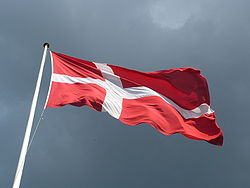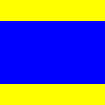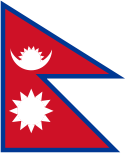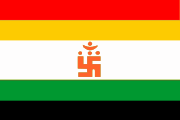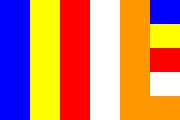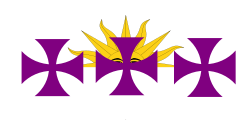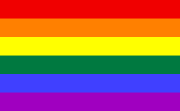Flag

A flag is a piece of fabric, often flown from a pole or mast, generally used symbolically for signalling or identification. It is most commonly used to symbolize a country. The term flag is also used to refer to the graphic design employed by a flag, or to its depiction in another medium.
The first flags were used to assist military coordination on battlefields, and flags have since evolved into a general tool for rudimentary signalling and identification, especially in environments where communication is similarly challenging (such as the maritime environment where semaphore is used). National flags are potent patriotic symbols with varied wide-ranging interpretations, often including strong military associations due to their original and ongoing military uses. Flags are also used in messaging, advertising, or for other decorative purposes. The study of flags is known as vexillology, from the Latin vexillum meaning flag or banner.
Contents |
History
The usage of flags spread from India and China, where they were almost certainly invented,[1] to neighboring Burma, Siam, and southeastern Asia.[1]
In antiquity, field signs or standards were used in warfare that can be categorized as vexilloid or "flag-like". Examples include the Achaemenid battle standard Derafsh Kaviani, and the standards of the Roman legions such as the eagle of Augustus Caesar's Xth legion, or the dragon standard of the Sarmatians; the latter was let fly freely in the wind, carried by a horseman, but judging from depictions it was more similar to an elongated dragon kite than to a simple flag.
During the High Middle Ages flags came to be used primarily as a heraldic device in battle, allowing more easily to identify a knight than only from the heraldic device painted on the shield. Already during the high medieval period, and increasingly during the Late Middle Ages, city states and communes such as those of the Old Swiss Confederacy also began to use flags as field signs. Regimental flags for individual units became commonplace during the Early Modern period.
During the peak of the age of sail, beginning in the early 17th century, it has been customary (and later a legal requirement) for ships to carry flags designating their nationality;[2] these flags eventually evolved into the national flags and maritime flags of today. Flags also became the preferred means of communications at sea, resulting in various systems of flag signals; see, International maritime signal flags.
Use of flags outside of military or naval context begins only with the rise of nationalist sentiment by the end of the 18th century; the earliest national flags date to that period, and during the 19th century it became common for every sovereign state to introduce a national flag.
National flags

.jpg)

One of the most popular uses of a flag is to symbolize a nation or country. Some national flags have been particularly inspirational to other nations, countries, or subnational entities in the design of their own flags. Some prominent examples include:
- The flag of Denmark is the oldest state flag still in use (dates back to the 13th century). This flag, called the Dannebrog, inspired the cross design of the other Nordic countries: Norway, Sweden, Finland, Iceland, and regional Scandinavian flags for the Faroe Islands, Åland, Scania and Bornholm, as well as flags for the non-Scandinavian Shetland and Orkney.
- The Tricolour of the Netherlands is the oldest tricolor, first appearing in 1572 as the Prince's Flag in orange–white–blue. Soon the more famous red–white–blue began appearing—it is however unknown why, though many stories are known. After 1630 the red–white–blue was the most commonly seen flag. The Dutch Tricolor has inspired many flags but most notably those of Russia, New York City, and South Africa (the 1928–94 flag).
- The national flag of France, the Tricolore was designed in 1794. As a forerunner of revolution, France's tricolour flag style has been adopted by other nations. Examples: Italy, Costa Rica, Dominican Republic, Ireland, Haiti, Romania, Mexico, etc.
- The flag of Russia, the source for the Pan-Slavic colors red, white and blue, adopted by many Slavic states and peoples as their symbols. Examples: Slovakia, Serbia, Croatia, Slovenia, and Bulgaria (with green replacing blue).
- The Union Flag (Union Jack) of the United Kingdom is the most commonly used. British colonies typically flew a flag based on one of the ensigns based on this flag, and many former colonies have retained the design to acknowledge their cultural history. Examples: Australia, Fiji, New Zealand, Tuvalu, and also the Canadian provinces of Manitoba, Ontario and British Columbia, and the American state of Hawaii; see commons:Flags based on British ensigns.
- The flag of the United States, also nicknamed The Stars and Stripes or Old Glory. In the same way that nations looked to France for inspiration, many countries were also inspired by the American Revolution, which they felt was symbolized in this flag. Examples: Liberia, Chile, Malaysia, Uruguay, and the French region of Brittany.
- The original tricolor Flag of Iran, the source for the Pan-Iranian colors Green, White and Red adopted by many Indo-Iranian or Aryan states and peoples as their symbols. Examples: Tajikistan, Kurdistan, Republic of Ararat, Talysh-Mughan. Some of Iran's non-Iranian neighboring countries also adopted these colors see Kuwait and Oman.
- Ethiopia was seen as a model by emerging African states of the 1950s and 1960s, as it was one of the oldest independent states in Africa. Accordingly, its flag became the source of the Pan-African colors, or "Rasta colors" to the ill-informed. Examples: Togo, Senegal, Ghana, Mali.
- The flag of Turkey, which is very similar to last flag of the old Ottoman Empire, has been an inspiration for the flag designs of many other Muslim nations. During the time of the Ottomans the crescent began to be associated with Islam and this is reflected on the flags of Algeria, Azerbaijan, Comoros, Malaysia, Mauritania, Pakistan and of Tunisia.
- The Pan-Arab colors, green, white, red and black, are derived from the flag of the Great Arab Revolt as seen on the flags of Jordan, Kuwait, Sudan, Syria, the United Arab Emirates, Western Sahara, Egypt, Iraq, Yemen and Palestine.
- The Soviet flag, with its golden symbols of the hammer and sickle on a red field, was an inspiration to flags of other communist states, such as East Germany, People's Republic of China, Vietnam, Angola, Afghanistan and Mozambique.
- The flag of Venezuela, created by Francisco de Miranda to represent the independence movement in Venezuela that later gave birth to the "Gran Colombia", inspired the individual flags of Colombia and Ecuador, both sharing three bands of color and three of them (Colombia, Ecuador, and Venezuela) sharing the yellow, blue and red.
- The flag of Argentina, created by Manuel Belgrano during the war of independence, was the inspiration for the United Provinces of Central America's flag, which in turn was the origin for the flags of Guatemala, Honduras, El Salvador, and Nicaragua.
National flag designs are often used to signify nationality in other forms, such as flag patches.
Civil flags
A civil flag is a version of the national flag that is flown by civilians on non-government installations or craft. The use of civil flags was more common in the past, in order to denote buildings or ships that were not manned by the military. In some countries the civil flag is the same as the war flag or state flag, but without the coat of arms, such as in the case of Spain, and in others it's an alteration of the war flag.
War flags
|
Several countries (including the United Kingdom and the Soviet Union) have had unique flags flown by their armed forces, rather than the national flag.
Other countries' armed forces (such as those of the United States or Switzerland) use their standard national flag. The Philippines' armed forces may use their standard national flag, but during times of war the flag is turned upside down—the only known case where an upside down national flag signifies a state of war (and not merely distress.) These are also considered war flags, though the terminology only applies to the flag's military usage.
Large versions of the war flag flown on the warships of countries' navies are known as battle ensigns. In war waving a white flag is a banner of truce.
Four distinctive African flags currently in the collection of the National Maritime Museum in Britain were flown in action by Itsekiri ships under the control of Nana Olomu during conflict in the late 19th century. One is the flag generally known as the Benin flag and one is referred to as Nana Olomu's flag.
International flags
Among international flags are the Flag of the United Nations, the Olympic flag, the Paralympic flag, The EU flag and the World Flag.
Flags at sea
|
Flags are particularly important at sea, where they can mean the difference between life and death, and consequently where the rules and regulations for the flying of flags are strictly enforced. A national flag flown at sea is known as an ensign. A courteous, peaceable merchant ship or yacht customarily flies its ensign (in the usual ensign position), together with the flag of whatever nation it is currently visiting at the mast (known as a courtesy flag). To fly one's ensign alone in foreign waters, a foreign port or in the face of a foreign warship traditionally indicates a willingness to fight, with cannon, for the right to do so. As of 2009, this custom is still taken seriously by many naval and port authorities and is readily enforced in many parts of the world by boarding, confiscation and other civil penalties.
In some countries yacht ensigns are different from merchant ensigns in order to signal that the yacht is not carrying cargo that requires a customs declaration. Carrying commercial cargo on a boat with a yacht ensign is deemed to be smuggling in many jurisdictions.
There is a system of international maritime signal flags for numerals and letters of the alphabet. Each flag or pennant has a specific meaning when flown individually.
As well, semaphore flags can be used to communicate on an ad hoc basis from ship to ship over short distances.
Shapes and designs
|
Flags are usually rectangular in shape (often in the ratio 2:3, 1:2, or 3:5), but may be of any shape or size that is practical for flying, including square, triangular, or swallow tailed. A more unusual flag shape is that of the flag of Nepal, which is in the shape of two stacked triangles. Other unusual flag shapes include the flag of Ohio and the flag of Tampa.
Many flags are dyed through and through to be inexpensive to manufacture, such that the reverse side is the mirror image of the obverse (front) side. This presents two possibilities:
- If the design is symmetrical in an axis parallel to the flag pole, obverse and reverse will be identical despite the mirror-reversal, such as the Indian Flag or Canadian Flag
- If not, the obverse and reverse will present two variants of the same design, one with the hoist on the left (usually considered the obverse side, see flag illustrations), the other with the hoist on the right (usually considered the reverse side of the flag). This is very common and usually not disturbing if there is no text in the design. See also US reverse side flag.
|
Some complex flag designs are not intended for through and through implementation, requiring separate obverse and reverse sides if made correctly. In these cases there is a design element (usually text) which is not symmetric and should be read in the same direction, regardless of whether the hoist is to the viewer's left or right. These cases can be divided into two types:
- The same (asymmetric) design may be duplicated on both sides. Such flags can be manufactured by creating two identical through and through flags and then sewing them back to back, though this can affect the resulting combination's responsiveness to the wind. Depictions of such flags may be marked with the symbol
 , indicating the reverse is congruent to (rather than a mirror image of) the obverse.
, indicating the reverse is congruent to (rather than a mirror image of) the obverse. - Rarely, the reverse design may differ, in whole or in part, from that of the obverse. Examples are the flag of Paraguay, the flag of Oregon, and the historical flag of the Soviet Union. Depictions of such flags may be marked with the symbol
 .
.
Common designs on flags include crosses, stripes, and divisions of the surface, or field, into bands or quarters—patterns and principles mainly derived from heraldry. A heraldic coat of arms may also be flown as a banner of arms, as is done on both the state flag of Maryland and the flag of Kiribati.
The flag of Libya, which consists of a rectangular field of green, is the only national flag using a single color and no design or insignia.
Colors are normally described with common names, such as "red", but may be further specified using colorimetry.

The largest flag [3]. is purported to be a 60,409.78 square meter flag of Morocco. It was unfurled in the southern Moroccan city of Dakhla in May 2010[4]. Although it is reported to have been certified by a representative of Guinness World Records, it is not yet shown as adjudicated on their website [5].
The smallest flag is believed to be a flag of Turkey, being 700 nm wide (in comparison, a human hair is typically 50,000 nm in diameter). It was produced at the Bilkent University Nanophysics Department.[6]
Religious flags
|
|
Flags can play many different roles in religion. In Buddhism, prayer flags are used, usually in sets of five differently colored flags. Many national flags and other flags include religious symbols such as the cross, the crescent, or a reference to a patron saint. Flags are also adopted by religious groups and flags such as the Jain flag and the Christian flag are used to represent a whole religion.
Linguistic flags
|
|
|
As languages rarely have a flag designed to represent them[7], it is a common practice, though unofficial, to use national flags to identify them. Examples of this use include:
- representing language skills of an individual, like a staff member of a company
- displaying available languages on a multilingual website or software.
Though this can be done in an uncontroversial manner in some cases, this can easily lead to some problems for certain languages:
- languages generating language dispute, such as Romanian and Moldavian which some consider two different languages; and
- languages spoken in more than one country, such as English, Arabic, French, German, Mandarin, Portuguese, Russian or Spanish.
In this second case, common solutions include symbolising these languages by:
- the flag of the country where the language originated
- the flag of the country having the largest number of native speakers
- a mixed flag of the both (when this is not the same)
- the flag of the country most identified with that language in a specific region (e.g. Portuguese Language: Flag of Portugal in Europe and Flag of Brazil in South America)
Thus, on the Internet, it is most common to see the English language associated to the flag of the United Kingdom, but sometimes to the flag of England, the flag of the United States or a US-UK mixed flag, usually divided diagonally.
In sports

Because of their ease of signalling and identification, flags are often used in sports.
- In football (soccer), linesmen carry small flags along the touch lines. They use the flags to indicate to the referee potential infringements of the laws, or who is entitled to possession of the ball that has gone out of the field of play, or, most famously, raising the flag to indicate an offside offence. Officials called touch judges use flags for similar purposes in both codes of rugby.
- In American and Canadian football, referees use flags to indicate that a foul has been committed in game play. The phrase used for such an indication is flag on the play. The flag itself is a small, weighted handkerchief, tossed on the field at the approximate point of the infraction; the intent is usually to sort out the details after the current play from scrimmage has concluded. In American football, the flag is usually yellow; in Canadian football, it is usually red.
- In yacht racing, flags are used to communicate information from the race committee boat to the racers. Different flags hoisted from the committee boat may communicate a false start, changes in the course, a cancelled race, or other important information. Racing boats themselves may also use flags to symbolize a protest or distress. The flags are often part of the nautical alphabetic system of International maritime signal flags, in which 26 different flags designate the 26 letters of the Latin alphabet.
- In auto and motorcycle racing, racing flags are used to communicate with drivers. Most famously, a checkered flag of black and white squares indicates the end of the race, and victory for the leader. A yellow flag is used to indicate caution requiring slow speed and a red flag requires racers to stop immediately. A black flag is used to indicate penalties.
- In addition, fans of almost all sports wave flags in the stands to indicate their support for the participants. Many sports teams have their own flags, and, in individual sports, fans will indicate their support for a player by waving the flag of his or her home country.
- Capture the flag is a popular children's sport.
- In Gaelic football and Hurling a green flag is use to indicate a goal while a white flag is used to indicate a point
- In Australian rules football, the goal umpire will wave two flags to indicate a goal (worth six points) and a single flag to indicate a behind (worth one point).
- For safety, dive flags indicate the locations of underwater scuba divers.
- In water sports such as Wakeboarding and Water-Skiing, an orange flag is held in between runs to indicate someone is in the water.
- Flag poles with flags of all shapes and sizes are used by marching bands, drum corps, and winter guard teams use flags as a method of visual enhancement in performances.
Swimming flags


In Australia, Canada, New Zealand, Philippines, and the United Kingdom a pair of red/yellow flags is used to mark the limits of the bathing area on a beach, usually guarded by surf lifesavers. If the beach is closed, the poles of the flags are crossed. The flags are colored with a red triangle and a yellow triangle making a rectangular flag, or a red rectangle over a yellow rectangle. On many Australian beaches there is a slight variation with beach condition signaling. A red flag signifies a closed beach (or, in the UK, some other danger), yellow signifies strong current or difficult swimming conditions, and green represents a beach safe for general swimming. In Ireland, a red and yellow flag indicates that it is safe to swim; a red flag that it is unsafe; and no flag indicates that there are no lifeguards on duty. Blue flags may also be used away from the yellow-red lifesaver area to designate a zone for surfboarding and other small, non-motorised watercraft.
Reasons for closing the beach include:
- dangerous rip
- hurricane warning
- no lifeguards in attendance
- overpolluted water
- sharks
- tsunami
- waves too strong
A surf flag exists, divided into four quadrants. The top left and bottom right quadrants are black, and the remaining area is white.
Signal flag "India" (a black circle on a yellow square) is frequently used to denote a "blackball" zone where surfboards cannot be used but other water activities are permitted.
Railway flags
Railways use a number of colored flags. When used as wayside signals they usually use the following meanings (exact meanings are set by the individual railroad company):
- red = stop
- yellow = proceed with care
- green or white or blue = proceed.
- a flag of any color waved vigorously means stop
- a blue flag on the side of a locomotive means that it should not be moved because someone is working on it (or on the train attached to it). A blue flag on a track means that nothing on that track should be moved. The flag can only be removed by the person or group that placed it.
- In the railway dominated steel industry this principle of "blue flag and tag" was extended to all operations at Bethlehem Steel, Lackawanna, NY. If a man went inside a large machine or worked on an electrical circuit for example, his blue flag and tag was sacrosanct. see: http://www.oshrc.gov/decisions/html_1990/79-2597.html
At night, the flags are replaced with lanterns showing the same colors.
Flags displayed on the front of a moving locomotive are an acceptable replacement for classification lights and usually have the following meanings (exact meanings are set by the individual railroad company):
- white = extra (not on the timetable)
- green = another section following
- red = last section
Additionally, a railroad brakeman will typically carry a red flag to make his or her hand signals more visible to the engineer. Railway signals are a development of railway flags.[8]
In politics
|
Social and political movements have adopted flags, to increase their visibility and as a unifying symbol.
The socialist movement uses red flags to represent their cause. The anarchism movement has a variety of different flags, but the primary flag associated with them is the black flag. In the 1970s, the rainbow flag was adopted as a symbol of the LGBT social movements. Bisexual and transgender pride flags were later designed, in an attempt to emulate the rainbow flag's success.
Some of these political flags have become national flags, such as the red flag of the Soviet Union and national socialist banners for Nazi Germany. The present Flag of Portugal is based on what had been the political flag of the Portuguese Republican Party previous to the 5 October 1910 revolution which brought this party to power.
Flagpoles

A flagpole, flagstaff, or staff can be a simple support made of wood or metal. If it is taller than can be easily reached to raise the flag, a cord is used, looping around a pulley at the top of the pole with the ends tied at the bottom. The flag is fixed to one lower end of the cord, and is then raised by pulling on the other end. The cord is then tightened and tied to the pole at the bottom. The pole is usually topped by a flat plate or ball called a "truck" (originally meant to keep a wooden pole from splitting) or a finial in a more complex shape.
Very high flagpoles may require more complex support structures than a simple pole, such as guy wires, or need be built as a mast. The highest flagpole in the world, at 160 m (525 ft), is that at Gijeong-dong in North Korea, the flag weighing about 270 kilograms (600 pounds) when dry.[9]
Since 2008 with 133 m (436 ft) the tallest free-standing flagpole in the world is the Ashgabat Flagpole in Turkmenistan, beating the formerly record holding Aqaba Flagpole in Jordan (size: 132 m; 433 ft).[10] It will however be outrivaled by the National Flag Square in Azerbaijan, which is currently under construction and will reach a height of 162 m (531 ft).[11] The Raghadan Flagpole in Amman is currently the third tallest free-standing flagpole in the world. It reaches a height of 126 m (410 ft); it is illuminated at night and can be seen from 25 km (16 miles) away.
The largest flag regularly hoisted in the world is the Brazilian national flag flown in the Square of the Three Powers in Brasilia, Brazilian capital. This flag is about 280 square meters (2240 square feet) and has never come down since opening in the mid 60s.
Design
Flagpoles can be designed in one piece with a taper (typically a cone taper or a Greek entasis taper),[12] or be made from multiple pieces to make them able to expand. In the United States, ANSI/NAAMM guide specification FP-1001-97 covers the engineering design of metal flagpoles to ensure safety.
Flags and communication
Semaphore is a form of communication that utilizes flags. The signalling is performed by an individual using two flags (or lighted wands), the positions of the flags indicating a symbol. The person who holds the flags is known as the signalman. This form of communication is primarily used by naval signallers. This technique of signalling was adopted in the early 1800s and is still used in various forms today.
The colors of the flags can also be used to communicate. For example; a white flag means, among other things, surrender or peace, a red flag can be used as a warning signal, and a black flag can mean war, or determined to defeat enemies.
See also
- Lists and galleries of flags
- Gallery of flags by design
- Gallery of flags by similarity
- Gallery of sovereign state flags
- List of flag names
- List of flags
- List of flags by country
- Timeline of national flags
- Unofficial flags
- Notable flag-related topics
- False flag
- Flag Day
- Flag desecration
- Flag etiquette
- Flag Patch
- Flag semaphore
- Flag terminology
- Flag throwing
- Pledge of Allegiance
- Standard-bearer (also enumerates various types of standards, both flag types and immobile ensigns)
- Vexillology
- Miscellaneous
- Petrosomatoglyph Symbols and prehistory
- Jolly Roger
References
- ↑ 1.0 1.1 flag. (2008). Encyclopædia Britannica. Chicago: Encyclopædia Britannica.
- ↑ Articles 90–94 of the UN Convention on the Law of the Sea
- ↑ Although Turkey painted a flag 17 times bigger in the mountains of North Cyprus, it is not considered as a flag by Guinness. http://www.fletcherledger.com/2009/13-4/strategic%20developments/Largest_flag_north_cyprus.jpg
- ↑ "Moroccan Flag Certified By Guinness Book As The World's Biggest Flag". Agence Maghreb Arabe Presse. 05/08/2010. http://www.map.ma/eng/sections/general/moroccan_flag_certif/view.
- ↑ Guinness World Records, The Largest Flag
- ↑ "Nano-Scale Turkish Flag Presented to Prime Minister Erdoğan". Bilkent News. May 2, 2006. http://www.bilkent.edu.tr/~Bilnews/issue_12_27/index.html.
- ↑ Why you should not use a flag as a symbol of language
- ↑ Calvert, J.B. (2004-07-25). "Early Railway Signals". University of Denver. http://mysite.du.edu/~etuttle/rail/sigs.htm. Retrieved 2007-10-07.
- ↑ "Korea's DMZ: Scariest place on Earth". CNN. February 20, 2002. http://edition.cnn.com/2002/WORLD/asiapcf/east/02/19/koreas.dmz/.
- ↑ "Flag of Turkmenistan". Official Homepage of the Republic of Turkmenistan. July 3, 2008. http://turkmenistan.gov.tm/_eng/2008/07/03/flag_of_turkmenistan_at_the_tallest_flagpole_in_the_world.html.
- ↑ "Wer baut den hoechsten Fahnenmast". Der Spiegel. September 9, 2008. http://www.spiegel.de/fotostrecke/fotostrecke-35119.html.
- ↑ "Cone Tapered vs. Venetian Entasis Tapered". Lingo Flagpoles Inc. Archived from the original on 2005-02-28. http://web.archive.org/web/20050228014231/http://lingoinc.com/tapers.htm.
- Australian Botany pages
- William G. Crampton; The World of Flags; Rand McNally; ISBN 0-528-83720-6 (hardcover, 1994).
- Samuel Finley Breese Morse
- Ultimate Pocket Flags of the World; Dorling Kindersley; ISBN 0-7894-2085-6; (1st American edition, hardcover, 1996).
External links
- World Flags List & World map
- Flags of the world, Flag images
- Flags Forum, discussion forum
- Interactive Flag Design, interactive flag design page using evolutionary algorithms
- Flag Identifier, tool for identifying a given flag
- Flag news and views
- Flags of all countries
- fotw.net, Flags of the World, an outstanding source of vexillological information, contributed to by a group of international volunteers.
- Historical World Flags all countries Database
- List of all Country Flags
- Glossary of Flag Terms and Phrases
- World Flag Database
- Flag icons and images
|
|||||||||||||||||||||||
